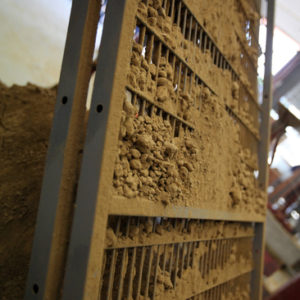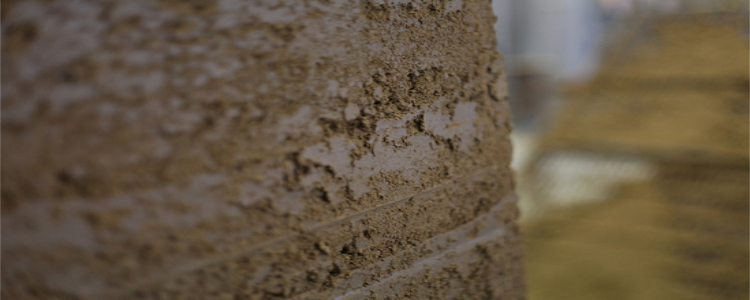Scientific orientations
The actions developed in this theme concern building envelope and structural elements. The theme focuses on understanding the thermal, mechanical and hydric responses of envelope and structural elements in new and existing buildings, with particular emphasis on non-conventional and multi-functional materials.
Scientific approach to the problem
Following on from the studies already undertaken at LOCIE on the behavior of wall elements or structures incorporating non-conventional low-gross-energy or low-carbon construction materials (development, modification, hygrothermal and mechanical characterization, coupling in porous media), the laboratory will be taking a further interest in multifunctional walls (mechanical and thermal) and their assemblies. A special section will be devoted to the study of the multi-layer materials required for these walls. The phenomena to be taken into account are numerous and concern coupled mass and heat transfers, the mechanical and hygrothermal behavior of walls, the collection and conversion of energy integrated into envelopes, the structural stability of buildings, the dynamics of structures and the behavior of building materials. To the complexity of the phenomena already mentioned, we will add phenomena linked to assemblies and multifunctionality.
To achieve this, we need to develop methods for structural and energy diagnostics of buildings. Methods based on dynamic experimental analysis and image correlation look very promising. The challenges are related to multi-physical behavior and the difficulty of in-situ measurements, and hence the need to reconstitute a valid model from minimally intrusive measurements. In this context, we will be looking at the development of innovative metrologies for humidity in building walls, such as the development of microwave sensors, or temperature and humidity sensors based on wireless technologies such as RFID.
Faced with the challenge of rehabilitating old walls, the reliability of modeling needs to be improved. Insulating old walls (adobe, etc.) disturbs the hygrothermal balance and can affect the mechanical cohesion of the material. The impact of this disturbance can be understood by studying the phenomena of coupled mass and heat transfer within the material, influenced by the environment (sunshine, wind, building users, heating, ventilation...). Highly hygroscopic materials (e.g. bio-sourced insulation, or other non-conventional materials) can reduce the amplitude of boundary condition variations ("buffering effect"). However, this behavior remains complex, and more accurate modeling requires taking into account new phenomena neglected in standard models (volume heterogeneity, hygro-thermo-mechanical couplings, sorption kinetics, impact of binders on properties, etc.), both within a material and at interfaces.
 This renovation challenge is an integral part of limiting the environmental impact of buildings. This effort sometimes requires repairs or strengthen the structure in place, from a mechanical point of view: for example, the protocol combining a stainless steel grid and mortar developed in the laboratory has produced promising results, and should be studied further. More generally, the use of low-carbon materials (raw earth, natural stabilizers or stabilizers derived from waste...) is an interesting alternative to traditional construction. For this, we need to study their multi-physical behavior, including their impact on indoor air quality.
This renovation challenge is an integral part of limiting the environmental impact of buildings. This effort sometimes requires repairs or strengthen the structure in place, from a mechanical point of view: for example, the protocol combining a stainless steel grid and mortar developed in the laboratory has produced promising results, and should be studied further. More generally, the use of low-carbon materials (raw earth, natural stabilizers or stabilizers derived from waste...) is an interesting alternative to traditional construction. For this, we need to study their multi-physical behavior, including their impact on indoor air quality.
The envelope of a building, whether new or renovated, can not only protect the interior space, but also meet certain energy needs (heating, cooling, electricity, etc.). This requires the implementation of coupled physical models of these multifunctional walls, and the development of approaches on very different spatial scales (from the elementary component, through its integration into the envelope with variable boundary conditions, to coupling with energy needs on the scale of the building or territory) and temporal scales (from daily sunshine variability to climate change).
Permanent workforce
Researchers attached to this theme represent 6.7 eq EC (including 2.30 Pr and 5.20 MCF), i.e. 3.35 ETP_R.
N.Prime (MCf, 100%), O. Plé (Pr, 100%), M. Woloszyn (Pr, 50%), C. Ménézo (Pr, 30%), J.P. Plassiard (MCf, 100%), A-C Grillet (MCf, 100%), S. Rouchier (MCf, 20%), A. Agbossou (Pr, 50%), A-L Perrier (MCf, 50%), M. Pailha (MCf, 50%), A. Lushnikova (MCf, 100%).
Resources mobilized
Action is already underway on most of these issues. On adobe, the MOPGA (stabilization of adobe), ADEME-Olimp (insulation of adobe) and ANR V-Batch (adobe structure) programs have just begun, enabling us to start or strengthen collaborations with the Politecnico di Milano, ENTPE and the ISTerre laboratory at USMB. With regard to the study of bio-sourced materials and their impact on the indoor environment, this will enable us to continue our collaboration with the Ho Chi Minh City University of Sciences in Vietnam. A new collaboration will also be developed with a team specializing in mold identification. This project, which has already been launched as part of a SCUSI Auvergne-Rhône Alpes program, will also enable the development of cross-disciplinary projects within LOCIE itself. All these projects will be based on various experimental facilities, either existing or being installed at LOCIE, which will need to be improved or adapted to the various projects (thermogravimetric analysis, double thermohygric chamber (RHBox), conductivity meter, structural platform, etc.). An MCF 60 has just been recruited to reinforce the diagnostic and mechanical repair aspects.
Partnerships and projects
PUCPR (Brazil), ENTPE -Lyon, Cethil - Lyon, CSTB -Grenoble, University of Sciences of Ho Chi Minh City Vietnam, UGA-Isterre, Politecnico di milano, CEREMA BPE SCUSI team (Region) , ANR V-Batch, OLIMP, SMART RENO and industrial collaborations (EDF, Léon Grosse, Filiaterre, Patriarche Architecture).
